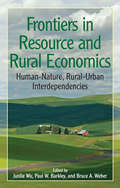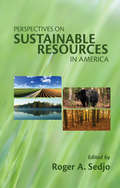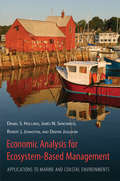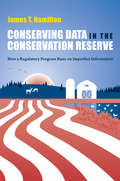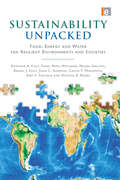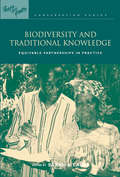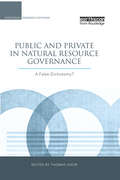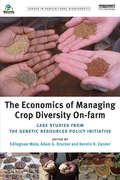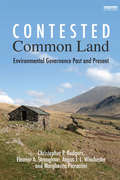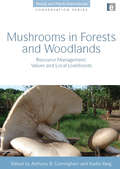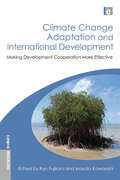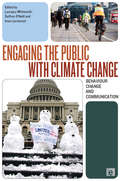- Table View
- List View
Frontiers in Resource and Rural Economics: "Human-Nature, Rural-Urban Interdependencies"
by Wu JunJie Paul W Barkley Bruce A WeberMost land in the United States is in rural areas, as are the sources of most of its fresh water and almost all its other natural resources. One of the first books to approach resource economics and rural studies as fundamentally interconnected areas of study, Frontiers in Resource and Rural Economics integrates the work of 18 leading scholars in resource economics, rural economics, rural sociology and political science in order to focus on two complex interdependencies-one pertaining to natural resources and human welfare, the other to urban and rural communities and their economies. The book reviews the past 50 years of scholarship in both natural resource and rural economics. It contrasts their different intellectual and practical approaches and considers how they might be refocused in light of pressing demands on human and natural systems. It then proposes a 'new rural economics' that acknowledges the full range of human-ecosystem and urban-rural interdependencies. It explores the relationship between natural resources and economic growth, and considers the prospects for amenity-driven growth that would benefit both new and traditional inhabitants of rural areas. Later chapters explore the politics of place, spatial economics, strategies for reducing rural poverty, and prospects for linking rural and environmental governance. Throughout, the book emphasizes innovative research methods that integrate natural resource, environmental, and rural economics.
Frontiers in Resource and Rural Economics: "Human-Nature, Rural-Urban Interdependencies"
by Wu JunJie Paul W Barkley Bruce A WeberMost land in the United States is in rural areas, as are the sources of most of its fresh water and almost all its other natural resources. One of the first books to approach resource economics and rural studies as fundamentally interconnected areas of study, Frontiers in Resource and Rural Economics integrates the work of 18 leading scholars in resource economics, rural economics, rural sociology and political science in order to focus on two complex interdependencies-one pertaining to natural resources and human welfare, the other to urban and rural communities and their economies. The book reviews the past 50 years of scholarship in both natural resource and rural economics. It contrasts their different intellectual and practical approaches and considers how they might be refocused in light of pressing demands on human and natural systems. It then proposes a 'new rural economics' that acknowledges the full range of human-ecosystem and urban-rural interdependencies. It explores the relationship between natural resources and economic growth, and considers the prospects for amenity-driven growth that would benefit both new and traditional inhabitants of rural areas. Later chapters explore the politics of place, spatial economics, strategies for reducing rural poverty, and prospects for linking rural and environmental governance. Throughout, the book emphasizes innovative research methods that integrate natural resource, environmental, and rural economics.
Perspectives on Sustainable Resources in America
by Roger A. SedjoThe vast size of the United States and extensive variation of its climate, topography, and biota across different regions contribute to both the richness of the nation?s natural heritage and the complexities involved in managing its resources. A follow-up to RFF?s popular America?s Renewable Resources (1990), Perspectives on Sustainable Resources in America updates readers about the current challenges involved in managing America?s natural resources, especially in light of the increasing emphasis on sustainability and ecosystem approaches to management. Written to inform general audiences and students, as well as to engage the interest of experts, the book includes assessments by some of the nation?s most renowned scholars in natural resource economics and policy. An introductory chapter critically examines the concept of sustainability as it has been developed in recent years and asks how the concept might apply to individual resource systems. It considers the interrelatedness of ecosystem, economic, and social sustainability; the paradigms of resource sufficiency and functional integrity; and the contrast between weak and strong sustainability. The chapters that follow examine America?s experience with forests, water, agricultural soils, and wildlife. Highlighting the adaptability and resilience of resource systems, each chapter provides a description of the physical characteristics of the resource, a history of its use, a policy history, and a review of ongoing debates in management and policy. Perspectives on Sustainable Resources in America concludes with an innovative treatment of biodiversity as a natural resource. The chapter reviews the definitions of biodiversity, the ecological and economic meanings of biodiversity, and current efforts to preserve biodiversity, especially through regulatory approaches.
Perspectives on Sustainable Resources in America
by Roger A. SedjoThe vast size of the United States and extensive variation of its climate, topography, and biota across different regions contribute to both the richness of the nation?s natural heritage and the complexities involved in managing its resources. A follow-up to RFF?s popular America?s Renewable Resources (1990), Perspectives on Sustainable Resources in America updates readers about the current challenges involved in managing America?s natural resources, especially in light of the increasing emphasis on sustainability and ecosystem approaches to management. Written to inform general audiences and students, as well as to engage the interest of experts, the book includes assessments by some of the nation?s most renowned scholars in natural resource economics and policy. An introductory chapter critically examines the concept of sustainability as it has been developed in recent years and asks how the concept might apply to individual resource systems. It considers the interrelatedness of ecosystem, economic, and social sustainability; the paradigms of resource sufficiency and functional integrity; and the contrast between weak and strong sustainability. The chapters that follow examine America?s experience with forests, water, agricultural soils, and wildlife. Highlighting the adaptability and resilience of resource systems, each chapter provides a description of the physical characteristics of the resource, a history of its use, a policy history, and a review of ongoing debates in management and policy. Perspectives on Sustainable Resources in America concludes with an innovative treatment of biodiversity as a natural resource. The chapter reviews the definitions of biodiversity, the ecological and economic meanings of biodiversity, and current efforts to preserve biodiversity, especially through regulatory approaches.
Economic Analysis for Ecosystem-Based Management: Applications to Marine and Coastal Environments
by Daniel Holland James Sanchirico Robert Johnston Deepak JoglekaOcean and coastal management regimes are increasingly subject to competing demands from stakeholders. Regulations must not only address fishing, recreation, and shipping, but also sand and gravel mining, gas pipelines, harbor/port development, offshore wind and tidal energy facilities, liquefied natural gas terminals, offshore aquaculture, and desalinization plants. The growing variety and intensity of ocean and coastal uses increases the call for a more holistic, comprehensive, and coordinated management approach that recognizes the often complex relationships between natural and human systems. For both economist and non-economist audiences, this book describes ways in which economic analysis can be an important tool to inform and improve ecosystem-based management (EBM). Topics include modeling economic impacts, benefit-cost analysis, spatial considerations in EBM, incentives and human behaviors, and accounting for uncertainty in policy analysis. Throughout the book the authors elucidate the different kinds of insights which can be gained from the use of different economic tools. In this rigorous and accessible work, the authors defy the conventional stereotype that economic perspectives necessarily favor the greatest commercial development. Instead, they demonstrate how comprehensive economic analyses consider the full range of potential services offered by marine and coastal ecosystems, including the conservation of biodiversity and creation of recreational opportunities.
Economic Analysis for Ecosystem-Based Management: Applications to Marine and Coastal Environments
by Daniel Holland James Sanchirico Robert Johnston Deepak JoglekaOcean and coastal management regimes are increasingly subject to competing demands from stakeholders. Regulations must not only address fishing, recreation, and shipping, but also sand and gravel mining, gas pipelines, harbor/port development, offshore wind and tidal energy facilities, liquefied natural gas terminals, offshore aquaculture, and desalinization plants. The growing variety and intensity of ocean and coastal uses increases the call for a more holistic, comprehensive, and coordinated management approach that recognizes the often complex relationships between natural and human systems. For both economist and non-economist audiences, this book describes ways in which economic analysis can be an important tool to inform and improve ecosystem-based management (EBM). Topics include modeling economic impacts, benefit-cost analysis, spatial considerations in EBM, incentives and human behaviors, and accounting for uncertainty in policy analysis. Throughout the book the authors elucidate the different kinds of insights which can be gained from the use of different economic tools. In this rigorous and accessible work, the authors defy the conventional stereotype that economic perspectives necessarily favor the greatest commercial development. Instead, they demonstrate how comprehensive economic analyses consider the full range of potential services offered by marine and coastal ecosystems, including the conservation of biodiversity and creation of recreational opportunities.
Conserving Data in the Conservation Reserve: How A Regulatory Program Runs on Imperfect Information
by James HamiltonEnrolling over 30 million acres, the U.S. Conservation Reserve Program (CRP) is the largest conservation program in the United States. Under the guidelines of the CRP, the federal government pays farmers to stop farming their land in the hopes of achieving a variety of conservation goals, including the reduction of soil erosion, improvement of water quality, and creation of wildlife habitat. In Conserving Data, James T. Hamilton explores the role of information in the policy cycle as it relates to the CRP. The author asks how the creation and distribution of information about what is going on across these millions of enrolled acres has influenced the development of the program itself. Of the many CRP stakeholders, each accesses a different set of information about the CRP?s operations. Regulators have developed the Environmental Benefits Index as a rough indicator of a field?s conservation benefits and adopted that measure as a way to determine which lands should be granted conservation contracts. NGOs have used publicly available data from these contracts to show how CRP monies are allocated. Members of Congress have used oversight hearings and GAO reports to monitor the Farm Service Agency?s conservation policy decisions. Reporters have localized the impact of the CRP by writing stories about increases in wildlife and hunting on CRP fields in their areas. Conserving Data brings together and analyzes these various streams of information, drawing upon original interviews with regulators, new data from Freedom of Information Act requests, and regulatory filings. Using the CRP as a launch point, Hamilton explores the role of information, including 'hidden information,' in the design and implementation of regulatory policy.
Conserving Data in the Conservation Reserve: How A Regulatory Program Runs on Imperfect Information
by James HamiltonEnrolling over 30 million acres, the U.S. Conservation Reserve Program (CRP) is the largest conservation program in the United States. Under the guidelines of the CRP, the federal government pays farmers to stop farming their land in the hopes of achieving a variety of conservation goals, including the reduction of soil erosion, improvement of water quality, and creation of wildlife habitat. In Conserving Data, James T. Hamilton explores the role of information in the policy cycle as it relates to the CRP. The author asks how the creation and distribution of information about what is going on across these millions of enrolled acres has influenced the development of the program itself. Of the many CRP stakeholders, each accesses a different set of information about the CRP?s operations. Regulators have developed the Environmental Benefits Index as a rough indicator of a field?s conservation benefits and adopted that measure as a way to determine which lands should be granted conservation contracts. NGOs have used publicly available data from these contracts to show how CRP monies are allocated. Members of Congress have used oversight hearings and GAO reports to monitor the Farm Service Agency?s conservation policy decisions. Reporters have localized the impact of the CRP by writing stories about increases in wildlife and hunting on CRP fields in their areas. Conserving Data brings together and analyzes these various streams of information, drawing upon original interviews with regulators, new data from Freedom of Information Act requests, and regulatory filings. Using the CRP as a launch point, Hamilton explores the role of information, including 'hidden information,' in the design and implementation of regulatory policy.
Sustainability Unpacked: Food, Energy and Water for Resilient Environments and Societies
by Kristiina Vogt Toral Patel-Weynand Maura Shelton Daniel J Vogt John C. Gordon Cal Mukumoto Asep. S. Suntana Patricia A. RoadsFood, water and energy form some of the basic elements of sustainability considerations. This ground-breaking book examines and decodes these elements, exploring how a range of countries make decisions regarding their energy and bio-resource consumption and procurement. The authors consider how these choices impact not only the societies and environments of those countries, but the world in general. To achieve this, the authors review the merits of various sustainability and environmental metrics, and then apply these to 34 countries that are ranked low, medium or high on the human development index. The book assesses their resource capacities and the environmental impacts, both within and outside their country boundaries, from consuming food, water, and energy. The final section uses the lessons derived from the earlier analyses of resource consumption to explore the importance of geography, climates and sustainable management of forests and other natural resources for building resilient societies in the future.
Sustainability Unpacked: Food, Energy and Water for Resilient Environments and Societies
by Kristiina Vogt Toral Patel-Weynand Maura Shelton Daniel J Vogt John C. Gordon Cal Mukumoto Asep. S. Suntana Patricia A. RoadsFood, water and energy form some of the basic elements of sustainability considerations. This ground-breaking book examines and decodes these elements, exploring how a range of countries make decisions regarding their energy and bio-resource consumption and procurement. The authors consider how these choices impact not only the societies and environments of those countries, but the world in general. To achieve this, the authors review the merits of various sustainability and environmental metrics, and then apply these to 34 countries that are ranked low, medium or high on the human development index. The book assesses their resource capacities and the environmental impacts, both within and outside their country boundaries, from consuming food, water, and energy. The final section uses the lessons derived from the earlier analyses of resource consumption to explore the importance of geography, climates and sustainable management of forests and other natural resources for building resilient societies in the future.
Biodiversity and Traditional Knowledge: Equitable Partnerships in Practice
by Sarah A LairdBiodiversity research and prospecting are long-standing activities taking place in a new legal and ethical environment. Following entry into force of the Convention on Biological Diversity in 1993, and other recent policy developments, expectations and obligations for research and prospecting partnerships have changed. However, to date there are few guides to integrating these concepts with practice. This book offers practical guidance on how to arrive at equitable biodiversity research and prospecting partnerships. Drawing on experience and lessons learned from around the world, it provides case studies, analysis and recommendations in a range of areas that together form a new framework for creating equity in these partnerships. They include researcher codes of ethics, institutional policies, community research agreements, the design of more effective commercial partnerships and biodiversity prospecting contracts, the drafting and implementation of national 'access and benefit-sharing' laws, and institutional tools for the distribution of financial benefits. As part of the People and Plants initiative to enhance the role of communities in efforts to conserve biodiversity and use natural resources sustainably, Biodiversity and Traditional Knowledge will be invaluable to students, researchers and local communities, academic institutions, international agencies, government bodies and companies involved in biodiversity research, prospecting and conservation.
Biodiversity and Traditional Knowledge: Equitable Partnerships in Practice
by Sarah A LairdBiodiversity research and prospecting are long-standing activities taking place in a new legal and ethical environment. Following entry into force of the Convention on Biological Diversity in 1993, and other recent policy developments, expectations and obligations for research and prospecting partnerships have changed. However, to date there are few guides to integrating these concepts with practice. This book offers practical guidance on how to arrive at equitable biodiversity research and prospecting partnerships. Drawing on experience and lessons learned from around the world, it provides case studies, analysis and recommendations in a range of areas that together form a new framework for creating equity in these partnerships. They include researcher codes of ethics, institutional policies, community research agreements, the design of more effective commercial partnerships and biodiversity prospecting contracts, the drafting and implementation of national 'access and benefit-sharing' laws, and institutional tools for the distribution of financial benefits. As part of the People and Plants initiative to enhance the role of communities in efforts to conserve biodiversity and use natural resources sustainably, Biodiversity and Traditional Knowledge will be invaluable to students, researchers and local communities, academic institutions, international agencies, government bodies and companies involved in biodiversity research, prospecting and conservation.
Public and Private in Natural Resource Governance: A False Dichotomy?
by Thomas Sikor?This volume develops the rich conceptual and empirical content of public-private relationships, increasingly acknowledged as the dominant realm of natural resource governance. Ten wonderful studies from around the world illuminate opportunities for advancing the theory, analysis and effective formation of sustainable systems of resource use. The book is excellent for courses in governance and public policy in any resource and environmental field.? JEFF ROMM, PROFESSOR FOR RESOURCE POLICY, UNIVERSITY OF CALIFORNIA AT BERKELEY, US ?The book addresses the theoretically and politically most important division of social organization into public and private. The authors bring an exciting, multidisciplinary perspective to bear on changing and multiple publics and the strength of relationships connecting these two spheres in rural development and natural resource governance. The contributions range from consumer health and food safety, soil science, forestry and water management to sociological and economic aspects of natural resource property and governance.? FRANZ VON BENDA-BECKMANN, MAX PLANCK INSTITUTE FOR SOCIAL ANTHROPOLOGY, GERMANY Natural resources have historically been considered as being governed in public or private spheres - that is, by the state on behalf of the people, or by companies or individuals driven by the market. This dichotomy between private and public is now recognized as overly simplistic, and it is clear that ?publics? and ?privates? operate at a range of levels and with differing degrees of separation or overlap. Bringing together a group of internationally respected researchers, this book provides a new perspective on prominent issues in resource governance, including the state, NGOs, civil society, communities, participation, devolution, privatization and hybrid institutions, highlighting the three-dimensional nature of relations between ?public? and ?private?. It builds on empirical analyses from six fields of natural resource governance - agri-environment, biodiversity, bioenergy, food quality and safety, forestry and rural water - and employs a comparative approach that goes beyond the specifi cities of individual policy fields, recognizing shared elements and allowing for a greater understanding of the dynamics underlying governance processes. Introductions to the volume and to each section summarize the key debates and highlight linkages between chapters. This is essential reading for academics, students and policy experts in natural resource governance, development and environmental policy.
Public and Private in Natural Resource Governance: A False Dichotomy?
by Thomas Sikor?This volume develops the rich conceptual and empirical content of public-private relationships, increasingly acknowledged as the dominant realm of natural resource governance. Ten wonderful studies from around the world illuminate opportunities for advancing the theory, analysis and effective formation of sustainable systems of resource use. The book is excellent for courses in governance and public policy in any resource and environmental field.? JEFF ROMM, PROFESSOR FOR RESOURCE POLICY, UNIVERSITY OF CALIFORNIA AT BERKELEY, US ?The book addresses the theoretically and politically most important division of social organization into public and private. The authors bring an exciting, multidisciplinary perspective to bear on changing and multiple publics and the strength of relationships connecting these two spheres in rural development and natural resource governance. The contributions range from consumer health and food safety, soil science, forestry and water management to sociological and economic aspects of natural resource property and governance.? FRANZ VON BENDA-BECKMANN, MAX PLANCK INSTITUTE FOR SOCIAL ANTHROPOLOGY, GERMANY Natural resources have historically been considered as being governed in public or private spheres - that is, by the state on behalf of the people, or by companies or individuals driven by the market. This dichotomy between private and public is now recognized as overly simplistic, and it is clear that ?publics? and ?privates? operate at a range of levels and with differing degrees of separation or overlap. Bringing together a group of internationally respected researchers, this book provides a new perspective on prominent issues in resource governance, including the state, NGOs, civil society, communities, participation, devolution, privatization and hybrid institutions, highlighting the three-dimensional nature of relations between ?public? and ?private?. It builds on empirical analyses from six fields of natural resource governance - agri-environment, biodiversity, bioenergy, food quality and safety, forestry and rural water - and employs a comparative approach that goes beyond the specifi cities of individual policy fields, recognizing shared elements and allowing for a greater understanding of the dynamics underlying governance processes. Introductions to the volume and to each section summarize the key debates and highlight linkages between chapters. This is essential reading for academics, students and policy experts in natural resource governance, development and environmental policy.
Ethnobotany: A Methods Manual
by Gary J. MartinEthnobotany, the study of the classification, use and management of plants by people, draws on a range of disciplines, including natural and social sciences, to show how conservation of plants and of local knowledge about them can be achieved. Ethnobotany is critical to the growing importance of developing new crops and products such as drugs from traditional plants. This book is the basic introduction to the field, showing how botany, anthropology, ecology, economics and linguistics are all employed in the techniques and methods involved. It explains data collection and hypothesis testing and provides practical ideas on fieldwork ethics and the application of results to conservation and community development. Case studies illustrate the explanations, demonstrating the importance of collaboration in achieving results. Published with WWF, UNESCO and Royal Botanic Gardens Kew.
Ethnobotany: A Methods Manual
by Gary J. MartinEthnobotany, the study of the classification, use and management of plants by people, draws on a range of disciplines, including natural and social sciences, to show how conservation of plants and of local knowledge about them can be achieved. Ethnobotany is critical to the growing importance of developing new crops and products such as drugs from traditional plants. This book is the basic introduction to the field, showing how botany, anthropology, ecology, economics and linguistics are all employed in the techniques and methods involved. It explains data collection and hypothesis testing and provides practical ideas on fieldwork ethics and the application of results to conservation and community development. Case studies illustrate the explanations, demonstrating the importance of collaboration in achieving results. Published with WWF, UNESCO and Royal Botanic Gardens Kew.
The Economics of Managing Crop Diversity On-farm: Case studies from the Genetic Resources Policy Initiative
by Edilegnaw WaleThe purpose of this book is to assess a variety of economic issues as they relate to agro-biodiversity and show how addressing these issues can assist in agro-biodiversity policy-making. This is illustrated using empirical data from some of the countries (Ethiopia, Nepal and Zambia) which are part of the Genetic Resources Policy Initiative. The empirical chapters apply the relevant economic methods, including regression analysis, choice experiments, hedonic pricing, contingent valuation and farm business income analysis. The authors discuss the economics of managing crop diversity on-farm in the context of crop variety attribute preferences, farmers' perception of agro-biodiversity loss, and value addition and marketing of the products of traditional crop varieties. The case studies include detailed analysis of traditional varieties of groundnut, maize, rice, sorghum, and teff. The results are relevant not only to GRPI countries but also to other countries concerned with the sustainable utilization of these resources. Overall, the studies illustrate how genetic resources issues can be integrated into rural development interventions.
The Economics of Managing Crop Diversity On-farm: Case studies from the Genetic Resources Policy Initiative
by Edilegnaw WaleThe purpose of this book is to assess a variety of economic issues as they relate to agro-biodiversity and show how addressing these issues can assist in agro-biodiversity policy-making. This is illustrated using empirical data from some of the countries (Ethiopia, Nepal and Zambia) which are part of the Genetic Resources Policy Initiative. The empirical chapters apply the relevant economic methods, including regression analysis, choice experiments, hedonic pricing, contingent valuation and farm business income analysis. The authors discuss the economics of managing crop diversity on-farm in the context of crop variety attribute preferences, farmers' perception of agro-biodiversity loss, and value addition and marketing of the products of traditional crop varieties. The case studies include detailed analysis of traditional varieties of groundnut, maize, rice, sorghum, and teff. The results are relevant not only to GRPI countries but also to other countries concerned with the sustainable utilization of these resources. Overall, the studies illustrate how genetic resources issues can be integrated into rural development interventions.
Contested Common Land: Environmental Governance Past and Present
by Christopher P. Rodgers Eleanor Straughton Angus J.L. Winchester Margherita PieracciniThis innovative and interdisciplinary book makes a major contribution to common pool resource studies. It offers a new perspective on the sustainable governance of common resources, grounded in contemporary and archival research on the common lands of England and Wales - an important common resource with multiple, and often conflicting, uses. It encompasses ecologically sensitive environments and landscapes, is an important agricultural resource and provides public access to the countryside for recreation. Contested Common Land brings together historical and contemporary legal scholarship to examine the environmental governance of common land from c.1600 to the present day. It uses four case studies to illustrate the challenges presented by the sustainable management of common property from an interdisciplinary perspective - from the Lake District, Yorkshire Dales, North Norfolk coast and the Cambrian Mountains. These demonstrate that cultural assumptions concerning the value of common land have changed across the centuries, with profound consequences for the law, land management, the legal expression of concepts of common 'property' rights and their exercise. The 'stakeholders' of today are the inheritors of this complex cultural legacy, and must negotiate diverse and sometimes conflicting objectives in their pursuit of a potentially unifying goal: a secure and sustainable future for the commons. The book also has considerable contemporary relevance, providing a timely contribution to discussion of strategies for the implementation of the Commons Act of 2006. The case studies position the new legislation in England and Wales within the wider context of institutional scholarship on the governance principles for successful common pool resource management, and the rejection of the 'tragedy of the commons'.
Contested Common Land: Environmental Governance Past and Present
by Christopher P. Rodgers Eleanor Straughton Angus J.L. Winchester Margherita PieracciniThis innovative and interdisciplinary book makes a major contribution to common pool resource studies. It offers a new perspective on the sustainable governance of common resources, grounded in contemporary and archival research on the common lands of England and Wales - an important common resource with multiple, and often conflicting, uses. It encompasses ecologically sensitive environments and landscapes, is an important agricultural resource and provides public access to the countryside for recreation. Contested Common Land brings together historical and contemporary legal scholarship to examine the environmental governance of common land from c.1600 to the present day. It uses four case studies to illustrate the challenges presented by the sustainable management of common property from an interdisciplinary perspective - from the Lake District, Yorkshire Dales, North Norfolk coast and the Cambrian Mountains. These demonstrate that cultural assumptions concerning the value of common land have changed across the centuries, with profound consequences for the law, land management, the legal expression of concepts of common 'property' rights and their exercise. The 'stakeholders' of today are the inheritors of this complex cultural legacy, and must negotiate diverse and sometimes conflicting objectives in their pursuit of a potentially unifying goal: a secure and sustainable future for the commons. The book also has considerable contemporary relevance, providing a timely contribution to discussion of strategies for the implementation of the Commons Act of 2006. The case studies position the new legislation in England and Wales within the wider context of institutional scholarship on the governance principles for successful common pool resource management, and the rejection of the 'tragedy of the commons'.
Mushrooms in Forests and Woodlands: Resource Management, Values and Local Livelihoods
by Anthony B. Cunningham Xuefei YangMany mushrooms - or the 'fruits of fungi' - are extremely valuable, wild-gathered products which are utilised for both their medicinal properties and as food. In many of the world's tropical and temperate forests, they are the primary source of income for the people who live there. These forests range from temperate woodlands and small forests to high altitude forests in the Himalaya and tropical miombo woodlands in south-central Africa. In south-west China, over 200 species of wild fungi in 64 genera are commercially traded while in Europe and North America, woodlands and small forests are the source of many highly-prized mushrooms and an essential resource for many small enterprises and collectors. Yet the increased demand for timber has resulted in the rapid expansion of forestry, which in turn has destroyed the natural habitat of many fungi, unbalancing both forest economics and ecology. Despite the economic, social and cultural values of fungi, there is a general lack of understanding of their importance to local livelihoods and forest ecology. This book aims to fill this gap and extends the People and Plants Conservation Series beyond the plant kingdom into the related world of fungi and mushrooms. It demonstrates the crucial roles that fungi play in maintaining forest ecosystems and the livelihoods of rural people throughout the world while providing good practice guidelines for the sustainable management of this resource and an assessment of economic value. It brings together the perspectives of biologists, anthropologists and forest and woodland managers to provide a unique inter-disciplinary and international overview of the key issues.
Mushrooms in Forests and Woodlands: Resource Management, Values and Local Livelihoods
by Anthony B. Cunningham Xuefei YangMany mushrooms - or the 'fruits of fungi' - are extremely valuable, wild-gathered products which are utilised for both their medicinal properties and as food. In many of the world's tropical and temperate forests, they are the primary source of income for the people who live there. These forests range from temperate woodlands and small forests to high altitude forests in the Himalaya and tropical miombo woodlands in south-central Africa. In south-west China, over 200 species of wild fungi in 64 genera are commercially traded while in Europe and North America, woodlands and small forests are the source of many highly-prized mushrooms and an essential resource for many small enterprises and collectors. Yet the increased demand for timber has resulted in the rapid expansion of forestry, which in turn has destroyed the natural habitat of many fungi, unbalancing both forest economics and ecology. Despite the economic, social and cultural values of fungi, there is a general lack of understanding of their importance to local livelihoods and forest ecology. This book aims to fill this gap and extends the People and Plants Conservation Series beyond the plant kingdom into the related world of fungi and mushrooms. It demonstrates the crucial roles that fungi play in maintaining forest ecosystems and the livelihoods of rural people throughout the world while providing good practice guidelines for the sustainable management of this resource and an assessment of economic value. It brings together the perspectives of biologists, anthropologists and forest and woodland managers to provide a unique inter-disciplinary and international overview of the key issues.
Climate Change Adaptation and International Development: Making Development Cooperation More Effective
by Ryo Fujikura Masato KawanishiClimate change impacts upon the world's poorest most heavily. It is therefore essential that international development initiatives focus on improving the ability of developing countries to adapt to the effects of climate change. This book, a product of research by the JICA-RI (Research Institute of the Japan International Cooperation Agency), examines climate change adaptation from the perspective of development cooperation in order to provide useful lessons for those engaged in research, policy and practice in this vital area. In this book the editors have brought together a wide range of case studies from across Africa and Asia, covering urban and rural areas and different sectors including water, agriculture and disaster management, in order to examine the following: o high-resolution climate change projection in Asia and how this can be used in planning appropriate adaptation responses o in-depth case studies of climate change projections, social, economic and environmental impact and vulnerability assessment and adaptation in rural Thailand and urban Philippines o cases across Africa for which climate data is less readily available and alternative approaches need to be adopted o the current situation amongst international donors o emerging issues caused by climate change In the introductory section, the editors draw together the full implications from the case studies to discuss how international communities can support adaptation in developing countries and to give an assessment of bilateral projects. They reflect on the lessons learned and offer recommendations for future research and international development cooperation.
Climate Change Adaptation and International Development: Making Development Cooperation More Effective
by Ryo Fujikura Masato KawanishiClimate change impacts upon the world's poorest most heavily. It is therefore essential that international development initiatives focus on improving the ability of developing countries to adapt to the effects of climate change. This book, a product of research by the JICA-RI (Research Institute of the Japan International Cooperation Agency), examines climate change adaptation from the perspective of development cooperation in order to provide useful lessons for those engaged in research, policy and practice in this vital area. In this book the editors have brought together a wide range of case studies from across Africa and Asia, covering urban and rural areas and different sectors including water, agriculture and disaster management, in order to examine the following: o high-resolution climate change projection in Asia and how this can be used in planning appropriate adaptation responses o in-depth case studies of climate change projections, social, economic and environmental impact and vulnerability assessment and adaptation in rural Thailand and urban Philippines o cases across Africa for which climate data is less readily available and alternative approaches need to be adopted o the current situation amongst international donors o emerging issues caused by climate change In the introductory section, the editors draw together the full implications from the case studies to discuss how international communities can support adaptation in developing countries and to give an assessment of bilateral projects. They reflect on the lessons learned and offer recommendations for future research and international development cooperation.
Engaging the Public with Climate Change: Behaviour Change and Communication
by Lorraine Whitmarsh Irene Lorenzoni Saffron O'NeillDespite increasing public awareness of climate change, our behaviours relating to consumption and energy use remain largely unchanged. This book answers the urgent call for effective engagement methods to foster sustainable lifestyles, community action, and social change. Written by practitioners and academics, the chapters combine theoretical perspectives with case studies and practical guidance, examining what works and what doesn't, and providing transferable lessons for future engagement approaches. Showcasing innovative thought and approaches from around the world, this book is essential reading for anyone working to foster real and lasting behavioural and social change.
